Benefits of Buying Gold Bars vs. Gold Coins: What I Tell Clients Before They Invest—and Why It Matters
Over the years, I've had thousands of conversations with clients—seasoned investors, first-timers, even Fortune 500 retirees—and two questions always come up: “Stephen, what's the real value of a gold coin?” and “Should I buy gold bars instead?” They're fair questions....
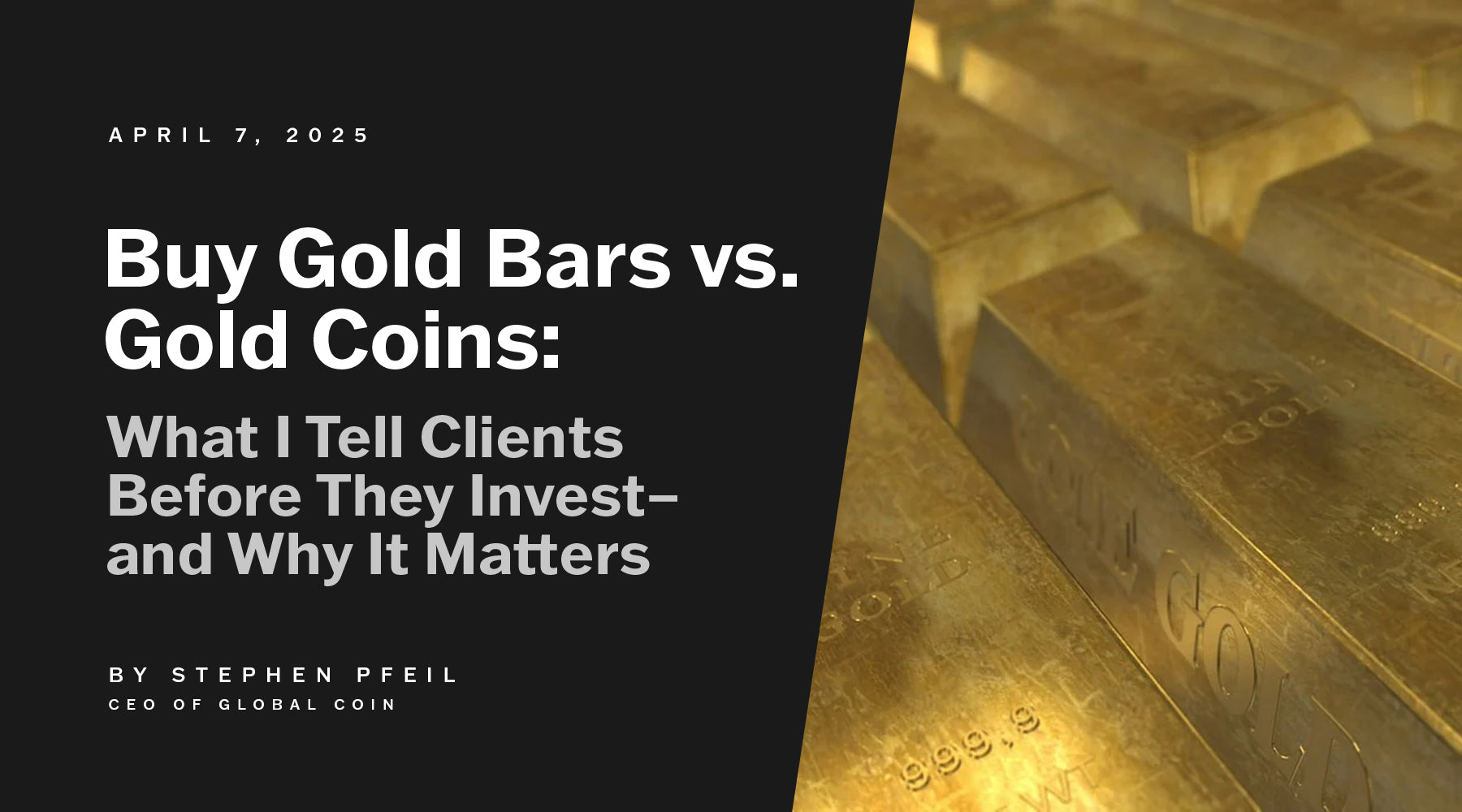
Over the years, I've had thousands of conversations with clients—seasoned investors, first-timers, even Fortune 500 retirees—and two questions always come up: “Stephen, what's the real value of a gold coin?” and “Should I buy gold bars instead?”
They're fair questions. Smart ones. After decades building Global Coin into a trusted name for high-net-worth individuals, here's my answer: It depends on why you're buying gold—and what you want your gold to do for you. Whether you're Googling “buy gold bars” for a low-cost stack or weighing “gold coin vs gold bar” for wealth preservation, the truth most articles miss is this: there's no one-size-fits-all.
Both gold coins and gold bars offer unique advantages and can complement each other in an investment portfolio.
Let me break it down the way I do for my clients—many of whom came to me after trial and error elsewhere. This isn't just a rundown of gold coin values or bar prices—it's how I help people like you make choices that secure freedom, family, and future. Because at Global Coin, the success of our company and your future depend on top rankings in this game.
The Starting Line: Gold Investment, Melt Value and Beyond

Every piece of gold—coin or bar—has a melt value. The value of a gold bar is easily calculated by multiplying its gold content by the current market price. Take a 1 oz 1986 American Gold Eagle: with gold at $2050 per ounce today, that’s $2050. A 1 oz gold bar? Same: $2050. But here’s where the gold coin vs gold bar debate heats up. Melt value is just the baseline—not the whole story.
For coins, the gold coins value comes from layers I’ve spent years mastering:
-
Rarity: Low-mintage coins, like the 1986 American Gold Eagle proof, are scarce and coveted.
-
Condition: An MS-70 grade from PCGS or NGC can push a coin to $5000—far beyond melt.
-
Demand: In shaky markets, collectors and investors bid these up fast.
-
History: The 1986 Eagle kicked off modern U.S. gold bullion—a milestone that adds depth.
-
Provenance: A coin from a notable collection? That’s a premium I can’t overlook.
Gold bars, though? When you buy gold bars, you’re closer to a commodity. Picture those James Bond-style bricks—most are 1 oz, 10 oz, or 1 kilo. Gram for gram, they’re cheaper, with little premium beyond melt value. A 1 oz PAMP Suisse bar might fetch $2080, tops. No rarity, no grading—just metal. At Global Coin, my GCS Index ranks coins for their hidden potential, while bars get a simpler nod for bulk stability. Both have a place, but coins often lead in upside.
The gold price significantly impacts the value of both gold coins and gold bullion bars. Gold bullion bars are unmonetized and available in various sizes, emphasizing their purity and the investment considerations for buyers.
Understanding Gold Coins and Gold Bars
When it comes to investing in gold, understanding the fundamental differences between gold coins and gold bars is crucial. Buying physical gold as a direct investment option offers the benefit of tangibility, ease of liquidation, and serves as a reliable store of value, but investors should also consider factors such as storage, insurance, and selecting reputable dealers. Gold coins are minted pieces of gold, often produced by government mints like the Royal Canadian Mint, and they come with a legal tender face value. These coins are not just currency; they are prized for their numismatic worth, aesthetic appeal, and historical significance. On the other hand, gold bars are uniform slabs of gold, typically with a purity of 99.99%, supplied by private refineries and sovereign mints. Unlike coins, gold bars do not have face values and are primarily used as a long-term store of value and a hedge against inflation and economic uncertainty.
Definitions and Differences
Gold Coin vs Gold Bar: The Flip Side Most Miss

I’ve seen it too often: folks assume gold is gold. “Spot’s $2050, so my bar or coin’s worth $2050,” they say. But let’s get real. A 1986 American Gold Eagle proof in MS-70? I’ve watched it hit $5500—not because of its ounce, but because it’s a rare, flawless collectible. A 1 oz gold bar? You’re lucky to see $2100, even from a top mint.
Here’s the gold coin vs gold bar truth: coins are strategic—liquidity, appreciation, legacy. Buying gold bars is straightforward—stack it, store it, done. Investors who buy gold bars from low-cost dealers often miss the resale catch: some foreign bars don’t move easily in the U.S. market. With competitive pricing and transparent market rates, investors know exactly what they are paying for, and the ease of selling gold bars directly impacts their value and liquidity. I’ve had clients get lowballed—or ignored—when it’s time to sell. Coins, especially certified ones, trade faster and hold trust. That’s why, at Global Coin, we don’t just sell gold—we unlock a market where coins like the 1986-W Eagle proof (mintage under 450,000) give you an edge.
When considering gold investment, it’s essential to weigh the pros and cons of gold bars versus gold coins. Your choice should align with your financial goals, market conditions, and personal circumstances.
Gold Coins Offer Agility, Bars for Bulk
My high-net-worth clients aren’t here for fun—they’re protecting wealth in a chaotic world. When considering investment strategies, many choose to buy gold coins like the 1986 American Gold Eagle for their agility: easier to sell, smaller denominations, and a story that bars can’t match. A 10 oz bar is a brick of value—great for quiet, long-term storage—but it’s not a gift or an heirloom. When I talk estate planning, coins become artifacts of family legacy. Bars? They’re just metal.
Gold coins offer better divisibility and liquidity than gold bars, allowing investors to sell or trade smaller amounts conveniently. In the gold coin vs gold bar debate, coins win for liquidity—certified by PCGS or NGC, they’re trusted at auctions or private sales. Bars win for low premiums if you’re stacking big. Both shield against inflation or market dips, but coins carry that extra spark. Your choice should align with your financial goals, market conditions, and personal circumstances. Gold bars and coins can help you achieve specific investment goals, provide financial security during economic uncertainty, and serve as a safe haven for your money. I’ve seen gold hold firm when stocks tank, and my hybrid portfolios—say, 60% bars for bulk, 40% coins for growth—keep clients ahead.
Beautiful Designs and Numismatic Value
One of the standout features of gold coins is their beautiful designs. These coins often showcase intricate artwork, cultural symbolism, and historical narratives, making them highly desirable to collectors and investors alike. For instance, the Royal Canadian Mint produces gold coins with stunning designs that are sought after for their artistic and numismatic value. Gold coins are also highly valued due to their global recognition, which enhances their liquidity and desirability across different markets. Over time, the numismatic value of these coins can appreciate, potentially offering lucrative returns. In contrast, gold bars have a more straightforward design, with their value primarily derived from their gold content. While they may lack the artistic flair of coins, gold bars are valued for their simplicity and purity.
Government Backing and Authenticity
Gold coins often come with the backing of government mints, which guarantees their authenticity and value. Mints like the Royal Canadian Mint adhere to strict quality control measures to ensure that their gold coins meet the highest standards of purity and craftsmanship. Coins and bars from the world's most reputable mints and refineries are internationally accepted and trusted. This government backing provides an added layer of trust and security for investors. Private mints also produce gold coins, but their authenticity and value can vary. Gold bars, on the other hand, are supplied by private refineries and sovereign mints, and their authenticity is often verified by third-party assay labs. This verification process ensures that gold bars are a reliable investment, even without the government backing that coins enjoy.
Advantages of Gold Bars

Gold bars offer several compelling advantages for investors, particularly when it comes to cost and liquidity. One of the primary benefits of gold bars is their lower premiums compared to gold coins. Because gold bars are simpler to produce and do not carry numismatic value, the premium over the gold content is typically lower, making them a more cost-effective option for investors. Purchasing bigger bars or larger bars often results in even lower premiums and more efficient storage options, as these bars are easier to store securely and are favored for their cost-effectiveness. Additionally, gold bars are highly liquid, meaning they can be easily sold or traded for cash. This high liquidity is due to the widespread recognition and acceptance of gold bars as a store of value. While gold coins may have higher premiums due to their collectible nature, gold bars tend to offer a more straightforward and efficient way to invest in gold.
Low Premiums and High Liquidity
Let me tell you what I’ve seen too often: investors prefer gold bars from flashy online dealers without a resale plan. They skip verification. They don’t realize some foreign mints won’t fetch top dollar here. When it’s time to sell, they’re stuck—or worse, ignored. Bars are excellent for long-term holds, but if you need agility in a crisis or want to ride rising demand, coins give you leverage.
Most gold bars are produced with lower premiums compared to gold coins due to lower production costs, making them an attractive option for investors looking to maximize their gold purchases. Gold investments, especially gold bars, have historically benefited from gold's strong performance during economic uncertainty and price increases, reinforcing their appeal as a stable asset in times of crisis.
That’s a lesson I’ve drilled into every client discussion at Global Coin.
Geopolitical Hedge: Gold’s Role in Turbulent Times
When the world gets shaky—be it political unrest, trade wars, or outright conflict—my clients know that gold is more than just a shiny metal. It’s a geopolitical hedge, a form of financial insurance that stands strong when other asset classes falter. I’ve seen investors move into physical gold—whether gold bars or gold coins—precisely because it’s universally recognized and valued, no matter what’s happening in the headlines. Unlike stocks or bonds, which can plummet on bad news, gold often rises in value during periods of economic uncertainty. That’s why, when building an investment portfolio, I always recommend considering gold’s unique role: it’s a tangible asset that can help shield your wealth from the unpredictable swings of global markets. Whether you’re holding a gold bar in a vault or a collection of gold coins, investing in gold is about more than returns—it’s about security when the world turns volatile.
Market Considerations: Timing, Pricing, and Trends

If there’s one thing I stress to every client, it’s this: timing and market awareness are everything when buying gold bars or coins. The price of gold—what we call the spot price—can shift quickly, driven by global events, inflation rates, and investor demand. Experienced investors don’t just watch the current market price; they track trends, follow central banks’ buying patterns, and pay attention to shifts in global demand. Some use dollar-cost averaging, buying gold at regular intervals to smooth out price swings and avoid chasing the market. Whether you’re looking to buy gold bars for bulk value or coins for flexibility, understanding the market landscape is crucial. Stay informed, watch gold prices, and don’t be afraid to wait for the right moment—because in gold investing, a few dollars difference per ounce can add up fast. And when it’s time to sell, knowing the market ensures you get the best value for your investment.
Storage and Security: Keeping Your Gold Safe
Owning physical gold is only half the battle—keeping it safe is just as important. I always tell clients: whether you’re stacking gold bars or collecting coins, secure storage is non-negotiable. Some prefer the convenience of a home safe, but that comes with risks—think theft, fire, or even just misplacement. For larger holdings, I recommend professional secure storage facilities or vaults, which offer top-tier security and insurance for your gold bars and coins. These services may come with a fee, but the peace of mind is worth it. Don’t forget to insure your holdings and keep documentation for verification—especially if you ever need to prove the value or authenticity of your gold. At the end of the day, the security of your investment is as important as the gold itself. Protect it wisely, and your physical gold will be there when you need it most.
Economic Uncertainty and Gold’s Safe Haven Appeal
When economic uncertainty hits—whether it’s inflation, currency swings, or a downturn in stocks and bonds—gold’s reputation as a safe haven shines. This precious metal has a proven track record of holding its value when other assets stumble. I’ve seen clients turn to gold during times of crisis, knowing it’s not tied to any single currency or economy. Central banks around the world continue to increase their gold reserves, recognizing its role as a universally recognized store of value. For investors, adding gold to an investment portfolio isn’t just about chasing returns—it’s about reducing exposure to economic uncertainties and protecting purchasing power. Gold’s limited supply and steady demand make it a reliable hedge against inflation and market volatility. In short, when the financial world gets rocky, gold stands firm—offering security, stability, and peace of mind for those who hold it.
My Playbook: Coins, Bars, and Winning Moves
Here’s how I guide clients—whether they buy either gold coins or chase gold coin values:
-
Scarcity or Stability: For coins, I hunt gems like the 1986 Eagle proof for upside. For bars, I stick to trusted mints like PAMP with tight premiums.
-
Grade or Purity: Coins need MS-70 for top gold coins value—$5500 vs $2500 for an MS-69. Bars need 99.99% purity, standard stuff.
-
Hybrid Power: I mix coins (1986-W Eagles) for appreciation and bars for ballast—think 60/40 for balance.
-
Expertise Over Hype: Too many buy blind from low-cost sites. My GCS Index and exclusive inventory ensure top rankings, whether it’s coins or bars.
Investing in gold is about understanding the intrinsic value of this precious metal and how it fits into your financial strategy.
The gold coin vs gold bar choice hinges on your goal: store wealth quietly with bars, or trade, grow, and pass down with coins. Do both? That’s where we shine.
A Client Story
Last year, a retiree asked me to weigh his options. I showed him a 1986 American Gold Eagle MS-70—$2050 melt, $5500 market. Then a 1 oz PAMP bar—$2050 melt, $2080 market. He picked the coin. Six months later, it climbed to $5700. The bar? Still $2080-ish. That’s the gold coin vs gold bar difference—and why I push for top rankings in every move.
Gold bars and gold coins are both excellent forms of precious metals investment, each with unique advantages.
Your Next Step
If you’re wondering whether to buy gold bars, chase the value of a gold coin, or both, let’s talk. At Global Coin, we’re not just about gold—we’re about what it does for your freedom, family, and future. From first-time buys to multi-million-dollar estates, my team’s got the inventory—1986 Eagles, premium bars—and the know-how to make it work.
Gold bars are often favored by those looking to invest in pure gold content, while gold coins offer beauty and reliability backed by governments.
When people invest in gold, they often consider other forms of precious metals as well, such as silver or platinum. Gold plays a significant role in the world market, acting as a hedge against inflation and currency fluctuations, especially when compared to fiat currencies, which can be devalued by central banks. Gold can be traded in various currencies, offering flexibility and protection during economic uncertainty. Additionally, gold alloys may contain other metals like copper or silver to enhance durability or create different types of jewelry. Each gold product—whether coins, bars, or jewelry—has its own set of advantages, allowing investors to choose what best fits their needs and goals.
The success of our company and your future depend on the choices we make, and I’m here to deliver. Reach out today. Let’s build a plan that’s more than ounces—it’s outcomes.
Related Articles
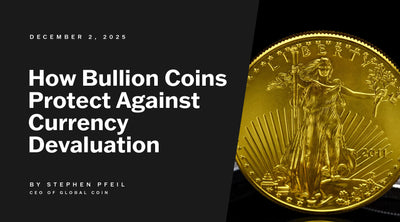
How Bullion Coins Protect Against Currency Devaluation
Hello, I'm Stephen, founder of Global Coin, where we specialize in post-1986 rare coins and prec...
Discover More
History and Design of the American Gold Eagle Coin
The Gold Eagle Coin is one of the most iconic and widely recognized bullion coins in the world. ...
Discover More
Investing in Gold Coins: What You Need to Know
Disclaimer: Global Coin is a dealer of precious metal coins and does not provide investment, fin...
Discover More

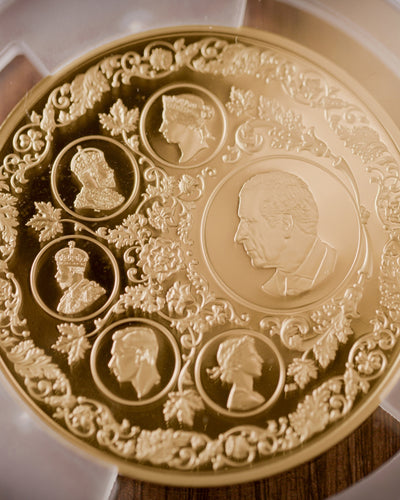
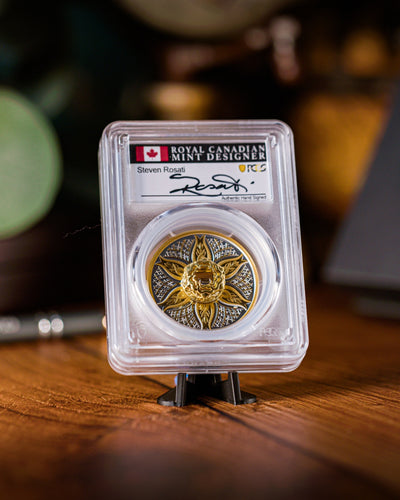
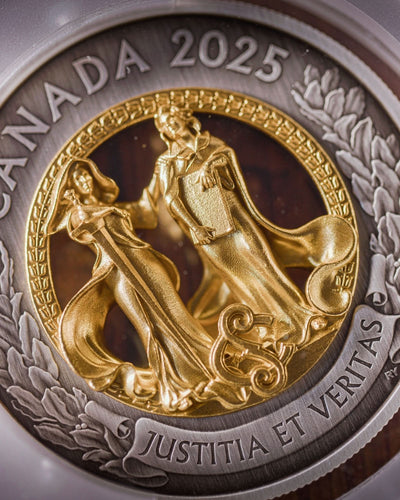
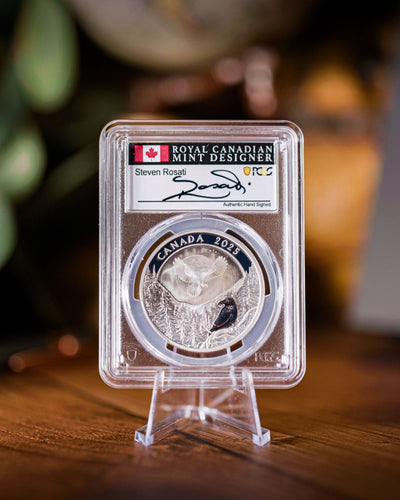
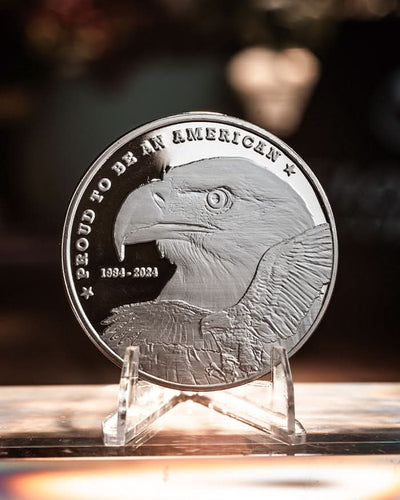
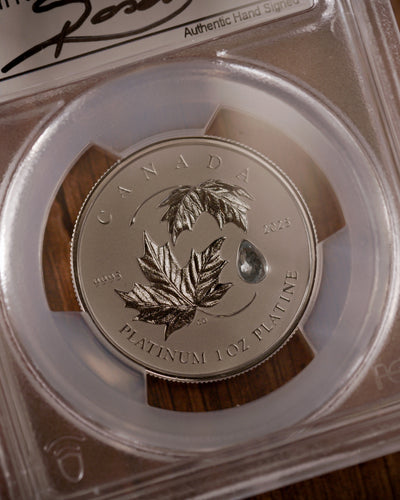

Leave a comment
This site is protected by hCaptcha and the hCaptcha Privacy Policy and Terms of Service apply.